Gaining An R.A.F Pilots Brevet In WW II
Join Date: Dec 2006
Location: Bury St. Edmunds
Age: 64
Posts: 539
Likes: 0
Received 0 Likes
on
0 Posts
Bonedome Comfort
Danny
All depended on the shape of your head! There was a Sikh corporal at North Luffenham who fitted me with my first helmet, a Mk. 3 C with dual visors in 1979. The only problem was that he insisted on giving me a Medium one.

It was agony! After only a short time I had a splitting headache. Happily I was re-issued a Medium Broad and it was fine. The only gripe was its weight. Under high g it was a pain, literally. This I think was why some pilots (certainly in the Air Defence world) preferred using their old Mk. 1A's with cloth inner......
Another downside (at least for the Mk.3) was that the ear seals were filled with fluid rather than foam, supposedly for better hearing protection. I had a seal burst and it was like having a nosebleed.
The real advantage of any helmet though is the birdstrike/wind blast protection the visors are supposed to offer and (in a dual control aircraft) when the hands-on pilot makes a sudden aileron input you find your head "lagging" the roll and hitting the side of the canopy! Without the helmet it could hurt.
MB
All depended on the shape of your head! There was a Sikh corporal at North Luffenham who fitted me with my first helmet, a Mk. 3 C with dual visors in 1979. The only problem was that he insisted on giving me a Medium one.


It was agony! After only a short time I had a splitting headache. Happily I was re-issued a Medium Broad and it was fine. The only gripe was its weight. Under high g it was a pain, literally. This I think was why some pilots (certainly in the Air Defence world) preferred using their old Mk. 1A's with cloth inner......
Another downside (at least for the Mk.3) was that the ear seals were filled with fluid rather than foam, supposedly for better hearing protection. I had a seal burst and it was like having a nosebleed.
The real advantage of any helmet though is the birdstrike/wind blast protection the visors are supposed to offer and (in a dual control aircraft) when the hands-on pilot makes a sudden aileron input you find your head "lagging" the roll and hitting the side of the canopy! Without the helmet it could hurt.
MB
Last edited by Madbob; 20th Mar 2014 at 13:27.
Guest
Posts: n/a
Helmets Ancient and Modern.
blind pew,
My apologies for my #5319! Of course the £199 relates to my Bond - we were talking about Isettas ! ("Senior Moments" we call them - I get quite a lot lately). Never did find out what Isettas cost new, around £8-9,000, I think, and you could buy a lot of proper car for that.....D.
Madbob,
Looks as if I was just as well off with my old leather and cloth, tropical, headgear. And you could screw them up in any old corner when not in use ! As for the birdies, the armoured glass front panel stopped most things...D.
Thanks, both. Danny.
My apologies for my #5319! Of course the £199 relates to my Bond - we were talking about Isettas ! ("Senior Moments" we call them - I get quite a lot lately). Never did find out what Isettas cost new, around £8-9,000, I think, and you could buy a lot of proper car for that.....D.
Madbob,
Looks as if I was just as well off with my old leather and cloth, tropical, headgear. And you could screw them up in any old corner when not in use ! As for the birdies, the armoured glass front panel stopped most things...D.
Thanks, both. Danny.
Last edited by Danny42C; 20th Mar 2014 at 23:54.
BTW,
The 'BMW' Isetta was actually of innovative Italian design & manufactured there by the Iso company.
B.Emm took a licence, replacing the Iso engine with their own four-stroke.
So, a) It was not of teutonic design & b) German engines clearly leaked too.
As for the Messerschmitt, the only fighter components were the draughtsmanship of the a/c factory who turned a crude original concept by Fritz Fend into a practical machine. In this case powered by an Austrian, Sachs two-stroke engine of ~192 cc.
The German & U.K. Clubs are very active offering spares and rallies, with a strong folllowing in N.America too.
mikehallam.
The 'BMW' Isetta was actually of innovative Italian design & manufactured there by the Iso company.
B.Emm took a licence, replacing the Iso engine with their own four-stroke.
So, a) It was not of teutonic design & b) German engines clearly leaked too.
As for the Messerschmitt, the only fighter components were the draughtsmanship of the a/c factory who turned a crude original concept by Fritz Fend into a practical machine. In this case powered by an Austrian, Sachs two-stroke engine of ~192 cc.
The German & U.K. Clubs are very active offering spares and rallies, with a strong folllowing in N.America too.
mikehallam.
May I recall the Nobel 200, reputedly based on the German Fuldamobil? It was assembled from various components in Belfast in the early 1960s, a venture not unconnected with the generous grants available to manufacturing at that time. The usual sequel was when the grants ran out, so did the recipients ...
Anyway the horrid little car on its tiny wheels was powered, if that's the word, by a 200cc Sachs two-stroke which could be started by key to run in either direction, giving it four speeds forward and four reverse. This opened interesting if disastrous possibilities, some of which transpired.
The last one I saw was in central Belfast, blazing merrily. Apparently a leaking carb had dribbled onto the hot exhaust pipe, but nobody heeded the clouds of blue smoke as this was quite normal for the two-stroke Sachs. It was indeed bad luck for the owner, as the exhaust pipe could be relied upon to fall off every 20 miles, a serendipitous if unintended safety feature.
Anyway the horrid little car on its tiny wheels was powered, if that's the word, by a 200cc Sachs two-stroke which could be started by key to run in either direction, giving it four speeds forward and four reverse. This opened interesting if disastrous possibilities, some of which transpired.
The last one I saw was in central Belfast, blazing merrily. Apparently a leaking carb had dribbled onto the hot exhaust pipe, but nobody heeded the clouds of blue smoke as this was quite normal for the two-stroke Sachs. It was indeed bad luck for the owner, as the exhaust pipe could be relied upon to fall off every 20 miles, a serendipitous if unintended safety feature.
I do remember the case of the proud new owner of an Isetta who drove it down the sloping ramp to his garage ,said garage having an up and over door.
Proud owner then tried to get out of the Isetta via the cars opening "front " door- which was unfortunately right up close to the garage door and wouldn't open more than a couple of inches.
Now finding that he was trapped in the bubble car, he then also realised that
it had no reverse gear.
Eventually his wife came home........
Proud owner then tried to get out of the Isetta via the cars opening "front " door- which was unfortunately right up close to the garage door and wouldn't open more than a couple of inches.
Now finding that he was trapped in the bubble car, he then also realised that
it had no reverse gear.
Eventually his wife came home........
Join Date: Mar 2010
Location: Often in Jersey, but mainly in the past.
Age: 79
Posts: 7,803
Received 135 Likes
on
63 Posts
FYI, the length of the typical OMQ garage was about 2" less than the LOA of a Jaguar XJ6. A strip of carpet nailed in the appropriate place on the end wall ensured you could (nervously) nudge up against it and then close the up-and-over door 

Yes, the same on the Meteor T7. The thing swung sideways over you with a deathly clang.....D.
Join Date: Sep 2006
Location: 59°09N 002°38W (IATA: SOY, ICAO: EGER)
Age: 80
Posts: 812
Likes: 0
Received 0 Likes
on
0 Posts
Valmorns said
No, I was at Cheadle 1973-76, Brora 76-82, Scarborough 82-92, Cheltenham 92-99 and Scarborough again 99-03 after which we moved up to Stronsay. Several visits to RAF Digby, HMS Mercury, Northwood etc
Our paths would not have crossed then, as I was in Hong Kong 1969-75, not exactly a punishment posting.
Guest
Posts: n/a
Danny has a mishap with the Isetta.
It must have been in the hard (but not as hard as '62/3) winter of '63/4. There had been a dump of snow, then a "high" had settled; the roads were hard packed snow and very icy. I fired up the Isetta (never any trouble) in the freezing dawn, huddled into my greatcoat and set off from Breighton. The first few miles were over country lanes until I turned onto the A19 at Escrick.
However, I'd been driving it for a few months now and was quite confident in the thing. There was no traffic on the lanes, I happily four-wheel-drifted round the bends, reached the A19 which was "black-top" (so no trouble through York - or on the other side) until I turned off for Linton-on-Ouse, on the back roads again for the last lap.
All went well until I got to Newton. There is a long, straight village street, and at the end a solid stone wall and a right angle bend over the old stream bridge. The weak winter sun had warmed the street a little. There was an evil glitter on it. Better be careful now.
I left the brakes alone, but played scales on the gearbox to use the back end as a sea-anchor. We'd slowed almost to walking pace as I was coming up to the bend. I tapped the brakes, and gingerly turned the wheel. The car stopped dead in its tracks - then started to rotate, quite slowly and smoothly, clockwise.
Only once had this happened to me before - in winter '47, late at night I'd stopped my old wreck at a traffic signal in Southport. Luckily there was nothing else about, but the thing had kept spinning for quite some time. This time I think I'd gone round once, and was just starting on the second turn. Over the bridge came a J2 RAF van.
He was travelling slowly and carefully, but braking action was about nil, neither of us could do anything about it. It wasn't much of a bang, but he punted me right across the road before we stopped and were able to get out (very precariously !) and assess damage. The J2 was unharmed - only a bit of my paint on the offside front bumper which had punched into my port quarter. But, although there was a fair dent, it was my lucky day, too - I'd taken it on the one spot of the bodywork which caused hardly any internal damage at all. And mechanically it was still perfect.
Once he'd assured himself that his J2 was all right, the MT driver's only concern was that I might try for damages from the RAF, but I calmed him, pointing out what was obvious - in the conditions it was a pure accident and nobody's fault; no claim could possibly succeed.
Most ironic of all: it was our ATC van, carrying an ATC crew out to the tower at Rufforth, which was used as a RLG for Linton. (Supplementary question: who provided the crash vehicles there ? - certainly not me). And of course there wasn't any point in their going out at all - Linton may have been fit to fly later that day, but Rufforth certainly wouldn't have been. I suppose it had been a case of no one with the nous to say "Stay where you are !" till after Briefing. When we'd disentangled ourselves, they continued on their way and I carried on to Linton.
"You're late!", said SATCO accusingly. "Yes, Sir", I said brightly: "I've just had a crash with our J2 on the way here". He turned pale (Command were very hot on road traffic accidents after the previous winter's woeful toll). I did my best to assure him that his precious J2 was unmarked (he wasn't in the least worried about me), but even so he insisted on my completing an MT Accident Report (Form ???). When asked on it to state my speed, I waggishly wrote: "Forward speed - Nil, Rotational speed - about 4 rpm". As I heard no more about it, I suppose that ended in the bin.
Bubwith village garage pulled out the dent, but a lot of paint came with it. In my garage there was a hardly touched can of some pale buff gloss enamel left behind some years before. I spent a happy couple of hours of unskilful brush work on the Isetta; it wasn't exactly in concours condition but good enough - and I even remembered to tell the Licencing Authority !
Goodnight, all.
Danny.
" It is better to travel hopefully than to arrive".
However, I'd been driving it for a few months now and was quite confident in the thing. There was no traffic on the lanes, I happily four-wheel-drifted round the bends, reached the A19 which was "black-top" (so no trouble through York - or on the other side) until I turned off for Linton-on-Ouse, on the back roads again for the last lap.
All went well until I got to Newton. There is a long, straight village street, and at the end a solid stone wall and a right angle bend over the old stream bridge. The weak winter sun had warmed the street a little. There was an evil glitter on it. Better be careful now.

I left the brakes alone, but played scales on the gearbox to use the back end as a sea-anchor. We'd slowed almost to walking pace as I was coming up to the bend. I tapped the brakes, and gingerly turned the wheel. The car stopped dead in its tracks - then started to rotate, quite slowly and smoothly, clockwise.
Only once had this happened to me before - in winter '47, late at night I'd stopped my old wreck at a traffic signal in Southport. Luckily there was nothing else about, but the thing had kept spinning for quite some time. This time I think I'd gone round once, and was just starting on the second turn. Over the bridge came a J2 RAF van.

He was travelling slowly and carefully, but braking action was about nil, neither of us could do anything about it. It wasn't much of a bang, but he punted me right across the road before we stopped and were able to get out (very precariously !) and assess damage. The J2 was unharmed - only a bit of my paint on the offside front bumper which had punched into my port quarter. But, although there was a fair dent, it was my lucky day, too - I'd taken it on the one spot of the bodywork which caused hardly any internal damage at all. And mechanically it was still perfect.
Once he'd assured himself that his J2 was all right, the MT driver's only concern was that I might try for damages from the RAF, but I calmed him, pointing out what was obvious - in the conditions it was a pure accident and nobody's fault; no claim could possibly succeed.
Most ironic of all: it was our ATC van, carrying an ATC crew out to the tower at Rufforth, which was used as a RLG for Linton. (Supplementary question: who provided the crash vehicles there ? - certainly not me). And of course there wasn't any point in their going out at all - Linton may have been fit to fly later that day, but Rufforth certainly wouldn't have been. I suppose it had been a case of no one with the nous to say "Stay where you are !" till after Briefing. When we'd disentangled ourselves, they continued on their way and I carried on to Linton.
"You're late!", said SATCO accusingly. "Yes, Sir", I said brightly: "I've just had a crash with our J2 on the way here". He turned pale (Command were very hot on road traffic accidents after the previous winter's woeful toll). I did my best to assure him that his precious J2 was unmarked (he wasn't in the least worried about me), but even so he insisted on my completing an MT Accident Report (Form ???). When asked on it to state my speed, I waggishly wrote: "Forward speed - Nil, Rotational speed - about 4 rpm". As I heard no more about it, I suppose that ended in the bin.
Bubwith village garage pulled out the dent, but a lot of paint came with it. In my garage there was a hardly touched can of some pale buff gloss enamel left behind some years before. I spent a happy couple of hours of unskilful brush work on the Isetta; it wasn't exactly in concours condition but good enough - and I even remembered to tell the Licencing Authority !
Goodnight, all.
Danny.
" It is better to travel hopefully than to arrive".
Guest
Posts: n/a
Haraka,
IIRC, all BMW Isettas had 4-speed + Rev in a "gated" box on your right (like the old racing cars). But it might have been one of the others (like the original Italian "Isos") that had a combined m/cycle engine/positive-stop gearbox , no reverse in that (until the 2-way ignition switch - which was really a counsel of despair - came in. Bond went for that, and others).
Whichever, he didn't have to wait for his wife. His escape route was over his head - out the sunroof !
MPN11,
I think you mean that the garage was 3in more than the XJ6 (bloated plutocrat !!). I've done the same with a length of thick plank.
Nitpickers of the world, unite !.... Danny.
IIRC, all BMW Isettas had 4-speed + Rev in a "gated" box on your right (like the old racing cars). But it might have been one of the others (like the original Italian "Isos") that had a combined m/cycle engine/positive-stop gearbox , no reverse in that (until the 2-way ignition switch - which was really a counsel of despair - came in. Bond went for that, and others).
Whichever, he didn't have to wait for his wife. His escape route was over his head - out the sunroof !
MPN11,
I think you mean that the garage was 3in more than the XJ6 (bloated plutocrat !!). I've done the same with a length of thick plank.
Nitpickers of the world, unite !.... Danny.
Danny42C
Earlier you recorded your experience with your purchase of your Peugeot 403 for use in Germany in the 1960’s. Here’s my experience of tax and duty-free car purchases when I was posted to JHQ Rheindahlen in the early 1970’s.
I was vaguely aware of the tax and duty-free shopping privileges available in Germany, but decided I’d make use of the UK’s Personal Export Scheme to buy a new car before I departed for Germany, so I sold my trusty Ford Anglia to a neighbour and with the proceeds had enough cash to put towards a new car.
At the time (late 1971) I wasn’t totally au-fait with the car purchase situation for Germany so was tempted enough to take advantage of the UK’s Personal Export Scheme whereby one bought a car in the UK without Purchase Tax provided one exported it permanently within a certain time (about three months I think) after purchase. With a young family and having examined the market and taken advice from friends, a new Austin Maxi 1750cc with rear seats that folded down to a bed seemed to be an ideal family car. So I went ahead and purchased a new Maxi as a personal export vehicle, paying the princely sum of £837 pounds i.e. UK price less Purchase Tax. I exported it in January 1971 and this car served me and the family well for our initial two years in Germany, but in 1974 knowing I’d be returning to the UK in mid-1975 decided that a new and up-market car at a BFG Tax and Duty free price would be a sensible long-term choice — the only stipulation to importing into the UK at the end of one’s tour without paying tax etc. was that it had to be registered in one’s name and be more than one-year old. No problems with this, as when I returned to the UK a year later I would meet these HM Customs’ requirements, and so it was.
At Rheindahlen one was spoilt for choice when buying a new car as on Saturdays the environs of the JHQ NAAFI and the car park outside were filled with a plethora of car dealers all after one’s custom.
Having taken to camping in a big way in the first two years of our tour in Germany, an estate car with plenty of room would tick all the boxes, so I arranged a test drive of a Volvo estate. The dealer was very generous and allowed one to drive around for half-a-day — and I was hooked. A Volvo 145 Estate it was to be. Altogether it cost me the equivalent to £1,300 sterling.
Despite the relatively low price, all car prices whether British, German and French or others included a “delivery” charge and for Volvos from Sweden to Germany the delivery charges were a bit on the steep side. After forty-years I can’t remember exactly what it was, but the dealer did suggest an alternative where one could take personal delivery at Volvo’s plant in Gothenburg in Sweden. Having done the sums it was clear that the cost of a railway journey from Moenchengladbach to Gothenburg plus the cost of a hotel and fuel for the return would be cheaper than paying the relatively steep “delivery charge”. So I opted for a “personal” collection from Volvo in Sweden. This was a relatively simple process. I paid a deposit to the dealer and he placed the order with Volvo. All that was necessary then was to get a bankers draft payable to Volvo for the balance from the bank where I banked in Germany (Rheindahlen’s Commerzbank). A copy of the BFG registration document as arranged in advance with the BFG licensing authorities, a green (insurance) card, BFG number plates, a GB sticker
and that was it.
The train journey from Moenchengladbach was via Hamburg (change), Copenhagen (change) and then direct to Gothenburg. The timetable showed I could leave Moenchengladbach in the evening, change late at night at Hamburg and catch the overnight train to Denmark arriving at Copenhagen very early in the morning. At Copenhagen one caught the first early morning train to Gothenburg. In those days international trains were conveyed by the ferry across the water, the passenger railway carriages were driven onto the ferry and driven off at the destination terminal, a new locomotive was attached and the journey continued to the destination. There was no way, except in an emergency of getting off the carriage whilst it was on the ferry, just stay in the carriage for the ferry crossing and it all worked well.
The journey from Germany to Sweden involved two sea crossings: The first from Hamburg to Copenhagen was the Puttgarden (Germany) and Røby (Denmark) ferry, the second from Copenhagen to Gothenburg with the ferry over the Øresund from Kronborg (Helsingør) in Denmark to Helsingborg in Sweden.
The Hamburg – Copenhagen train was overnight in a carriage with couchettes. The journey was relatively short and although the train arrived in Copenhagen at about 05.00, one was allowed to stay in the carriage until about 06.30 or so which allowed for breakfast in the station buffet before boarding the onward connection for Gothenburg in Sweden that left at 07.34.
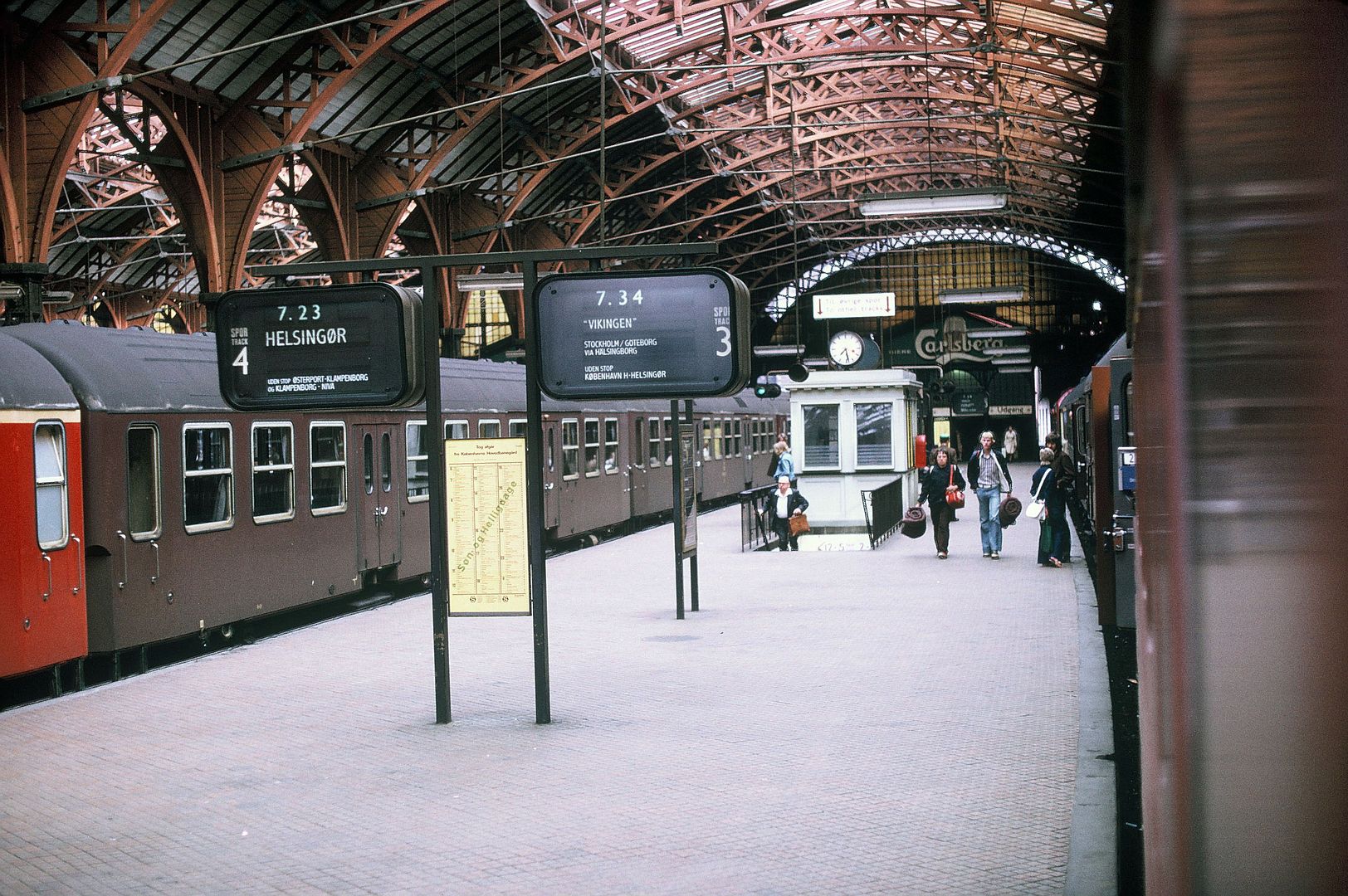
This shows the 07:34 Stockholm and Gothenburg train (“The Vikingen”) waiting at Copenhagen to depart for Gothenburg.
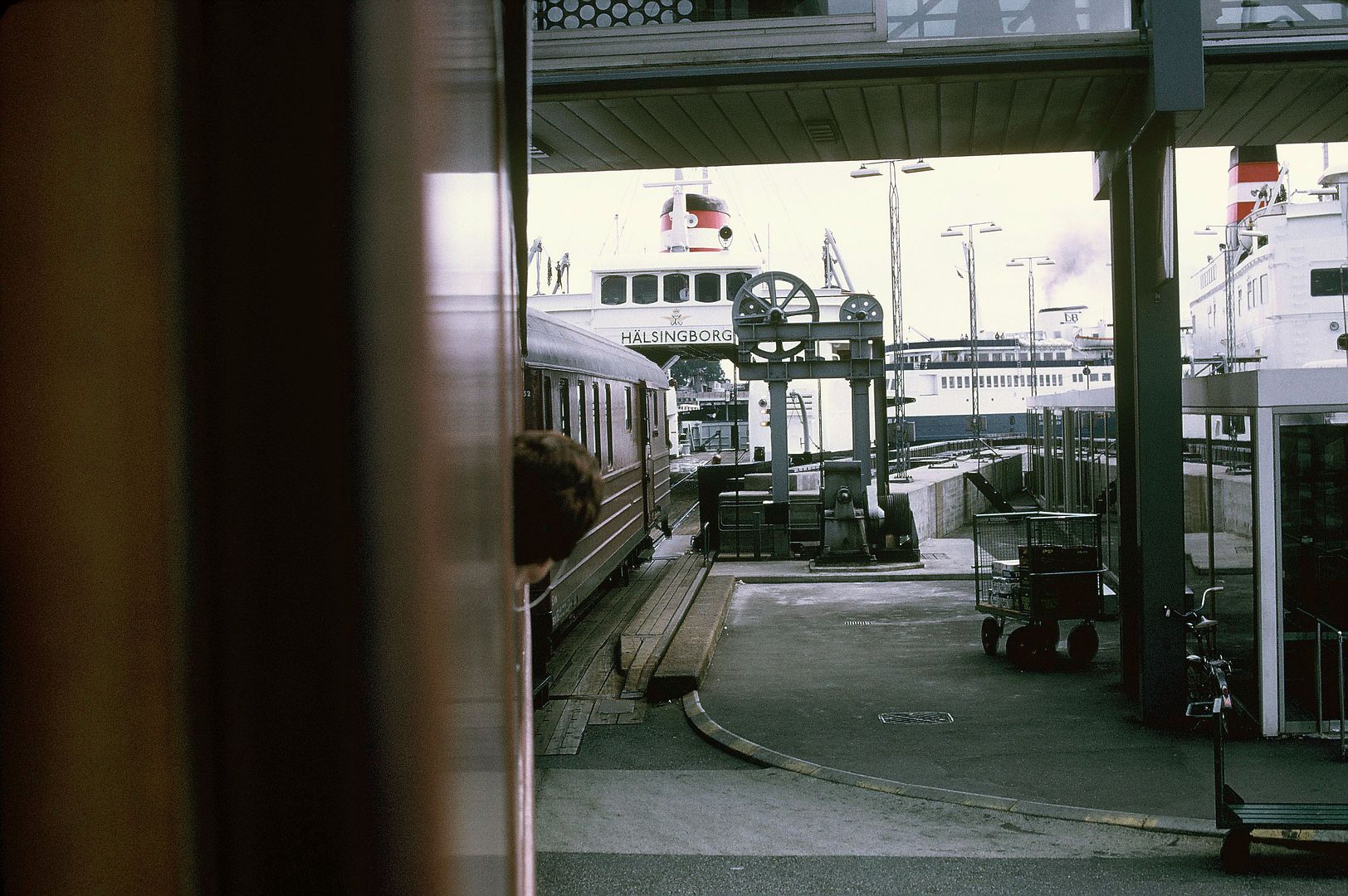

The ferry on the Øresund from Kronborg (Helsingør) in Denmark to Helsingborg in Sweden.
I’d been instructed to ring Volvo’s Tourist Delivery Centre when the train arrived at Gothenburg and they responded by sending a car to collect me from the station and take me to Volvo’s Tourist Delivery Centre. Volvo’s delivery service worked well and the formalities were dealt with efficiently.
The banker’s draft was handed over, documents checked etc and the BFG number plates and GB sticker affixed. This took a little while but the icing on the cake, and totally unexpected was that Volvo had arranged a free overnight stay in a Gothenburg hotel which allowed for a bit of sightseeing and the chance to have a good Swedish meal (with fish of course!). So the next day after an early breakfast I departed Gothenburg south towards Copenhagen (200-miles) my next planned night stop.
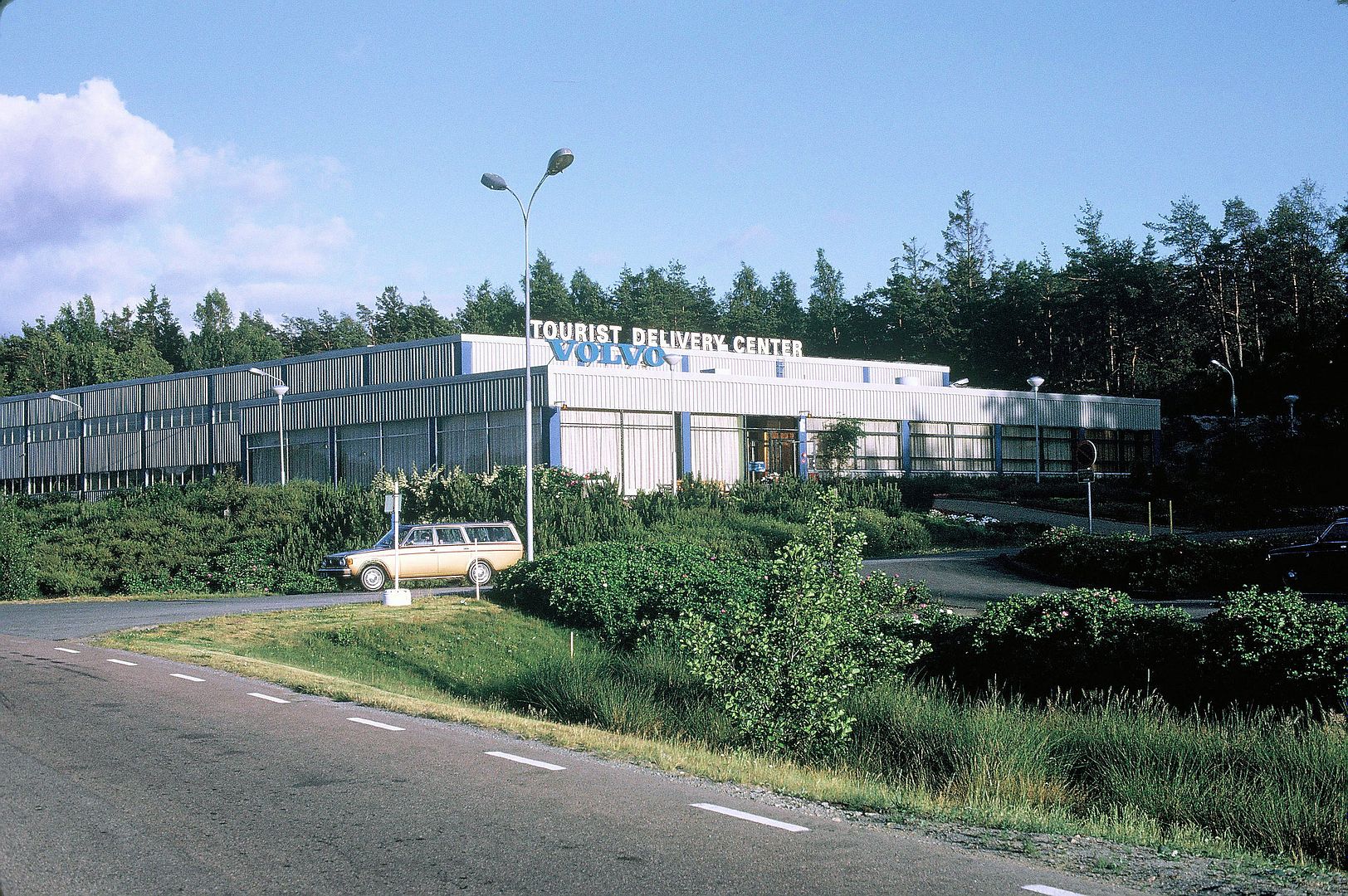
Taking delivery of my new Volvo at the Volvo Tourist Delivery Centre.
I took delivery in June. The weather was absolutely gorgeous and being mid-summer I was pleasantly surprised by the strong sunlight and almost Mediterranean look of the Kattegat as I travelled south down the west coast of Sweden to Helsingborg to take the car-ferry back over the Øresund to Helsingør in Denmark.
The west coast of Sweden had absolutely stunning scenery as seen below.
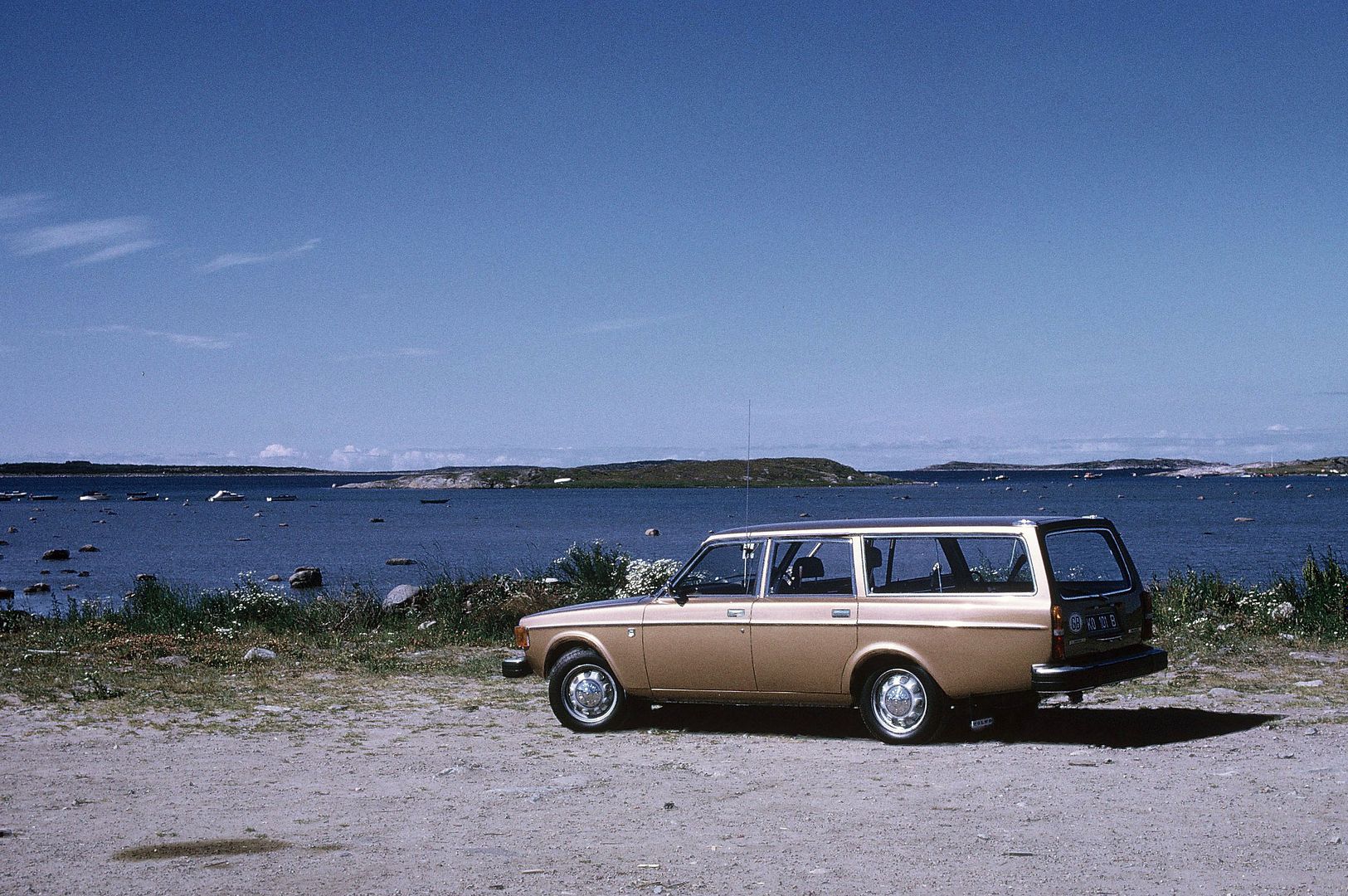

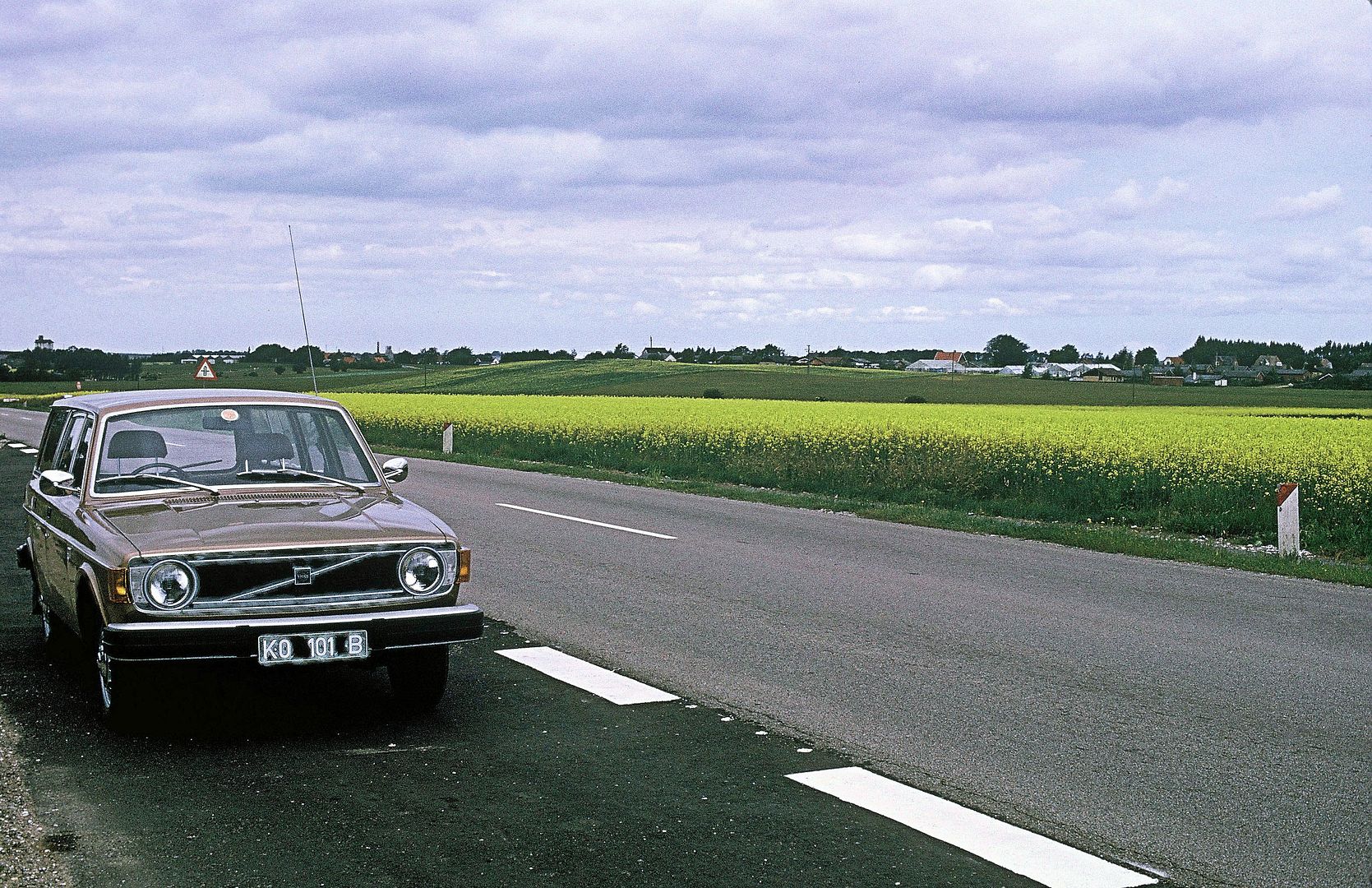
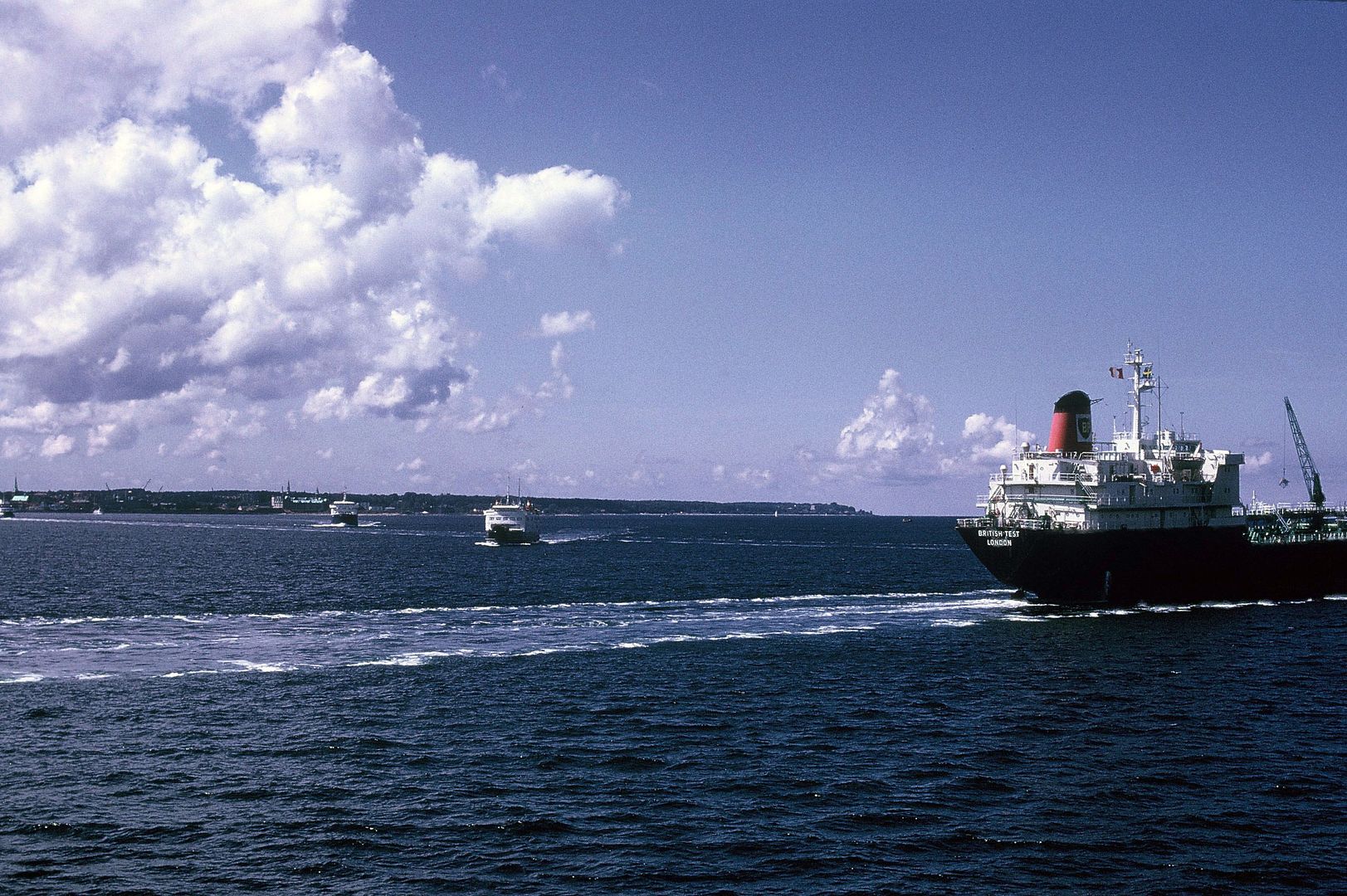
In 1974 the Sweden to Denmark ferries over the Øresund were reputed to be the busiest in the world, probably right as my photo shows.
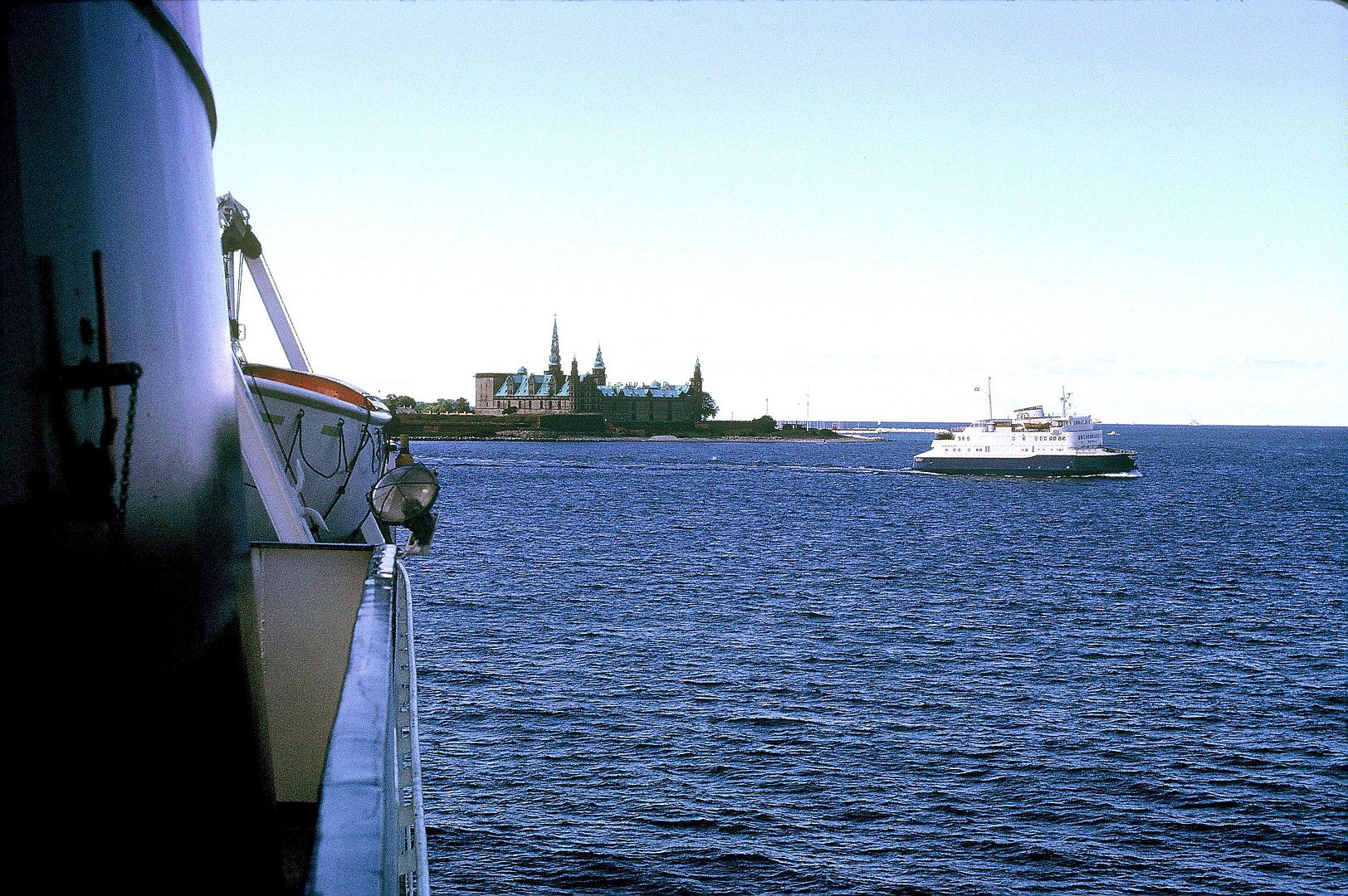
One of the sights from the ferry as one approached the ferry terminal at Helsingør in Denmark is Kronborg Castle, made famous as Elsinore castle in Shakespeare’s Hamlet.
One of our friends at JHQ was formerly with the DA’s staff at our Copenhagen embassy and knowing I was to visit Copenhagen made some useful suggestions about what I should do and see whilst I was there. So having booked into a motel in Copenhagen I went into town and did the usual tourist attractions like the Little Mermaid in Copenhagen Harbour and Copenhagen’s Tivoli Gardens.

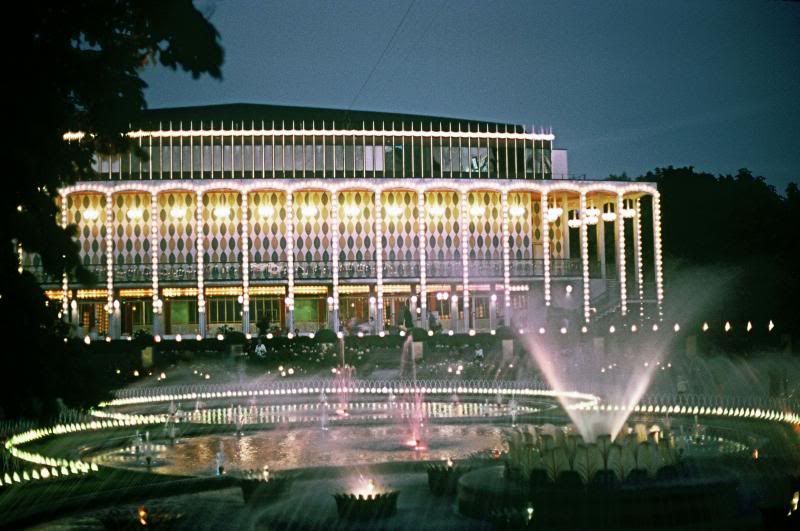
The other strong recommendation was to visit the Viking Ship Museum which overlooks the nearby Roskilde Fjord. This was a fascinating place with the remains of various Viking longships. The museum building itself was a “brutalist” modern concrete structure alongside the water which didn’t appeal at all, but the contents were fabulous. To see (and touch) the wooden remains of five Viking longships that had been sailed by the Vikings nearly a thousand years earlier is one of my better museum experiences.
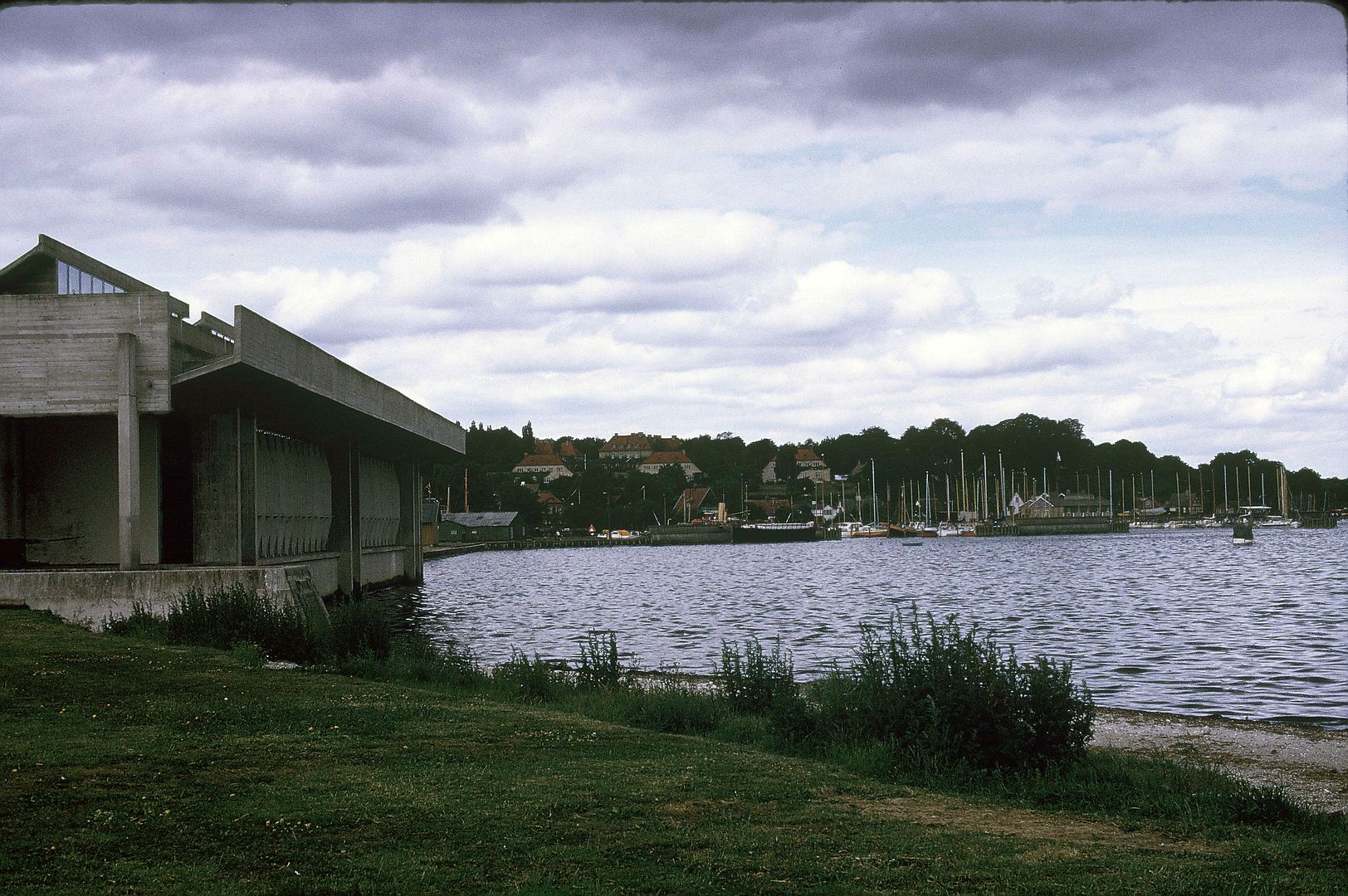
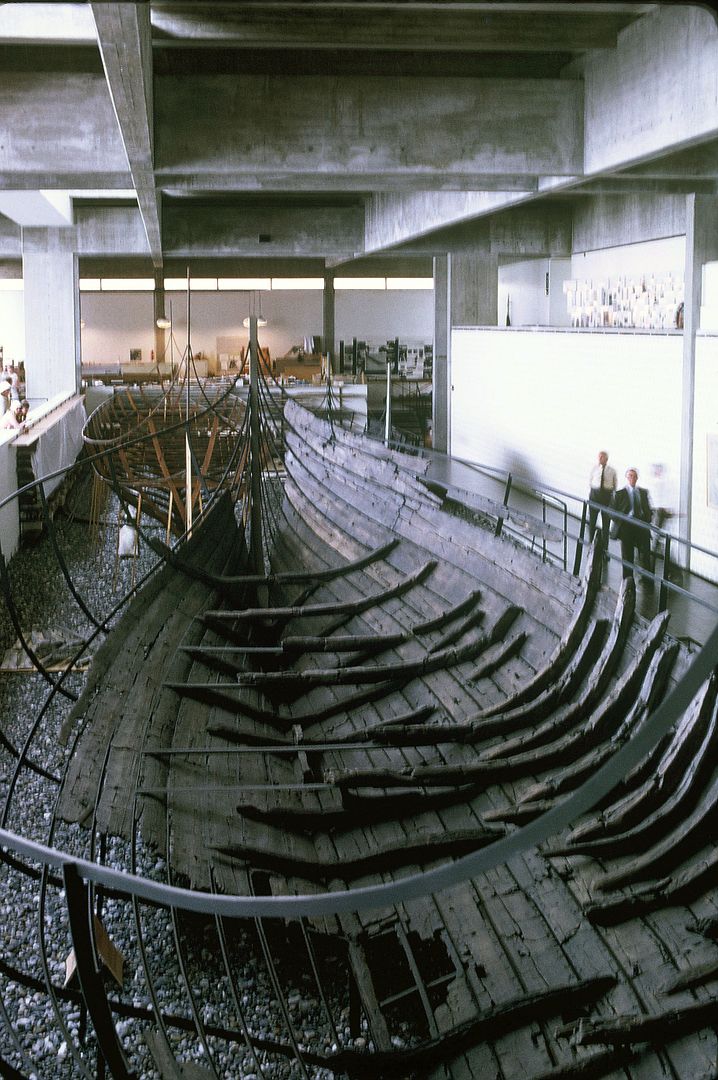

The Viking Ship Museum was built in 1969 especially to exhibit the five newly discovered ships. In the late 1990s excavations for an expansion of the museum uncovered the remains of a further nine ships including at 37 metres the longest Viking warship ever discovered.
It just so happens that the surviving timbers of this 37-metre longship are at the centre of the just opened “Vikings – Life and Legend” exhibition that runs from 6 March – 22 June 2014 at the British Museum. Due to its scale and fragility it would not have been possible to display this ship at the British Museum without the new facilities of the Sainsbury Exhibitions Gallery — so if in London, well worth a visit.
Another early start the next day for the nearly 500-miles journey from Copenhagen to Moenchengladbach. This involved another ferry crossing from Røby to Puttgarden, another busy ferry route (one every 30-minutes), back in 1974 there was no need to make a reservation; one turned up, paid for the crossing and caught the next ferry – simple! As before the car ferry also transported railway wagons, in the opposite direction to what I’d done two days before!
Having landed in Germany I used the BFG Petrol Coupons to fill up cheaply and from there onwards it was mainly Autobahn all the way back to Moenchengladbach.
On arrival at MG the car was just about run-in and ready for its first service.
Postscript
In the 1960’s service personnel all over the world took advantage of the duty-free or availability of cheap cars (compared to the relatively highly taxed price of car in the UK). Whilst I was with 99 Sqn (Britannias) from 1959-1963 I remember the many occasions when we flew back to the UK in a freight or Pax/freight role and offered the empty freight space to Air Movements at Changi or Khormaksar. They in turn would regularly put a couple of servicemen’s private cars aboard as “indulgence” freight. In Germany of course most would drive their cars back to the UK.
Today apart from the rump of what’s left of the British Forces' presence in Germany who I assume still have duty-free privileges and possibly Cyprus I’m not sure how many overseas postings offer the chance to buy a car cheaply.
The just published annual report of The Service Children’s Education (SCE) has an interesting map showing the location of service schools worldwide. So if there are schools, there are children and parents, and parents with children normally equate to a family with a car. As the attached map shows, Germany and Cyprus are the major locations with families living locally.

More to follow
Earlier you recorded your experience with your purchase of your Peugeot 403 for use in Germany in the 1960’s. Here’s my experience of tax and duty-free car purchases when I was posted to JHQ Rheindahlen in the early 1970’s.
I was vaguely aware of the tax and duty-free shopping privileges available in Germany, but decided I’d make use of the UK’s Personal Export Scheme to buy a new car before I departed for Germany, so I sold my trusty Ford Anglia to a neighbour and with the proceeds had enough cash to put towards a new car.
At the time (late 1971) I wasn’t totally au-fait with the car purchase situation for Germany so was tempted enough to take advantage of the UK’s Personal Export Scheme whereby one bought a car in the UK without Purchase Tax provided one exported it permanently within a certain time (about three months I think) after purchase. With a young family and having examined the market and taken advice from friends, a new Austin Maxi 1750cc with rear seats that folded down to a bed seemed to be an ideal family car. So I went ahead and purchased a new Maxi as a personal export vehicle, paying the princely sum of £837 pounds i.e. UK price less Purchase Tax. I exported it in January 1971 and this car served me and the family well for our initial two years in Germany, but in 1974 knowing I’d be returning to the UK in mid-1975 decided that a new and up-market car at a BFG Tax and Duty free price would be a sensible long-term choice — the only stipulation to importing into the UK at the end of one’s tour without paying tax etc. was that it had to be registered in one’s name and be more than one-year old. No problems with this, as when I returned to the UK a year later I would meet these HM Customs’ requirements, and so it was.
At Rheindahlen one was spoilt for choice when buying a new car as on Saturdays the environs of the JHQ NAAFI and the car park outside were filled with a plethora of car dealers all after one’s custom.
Having taken to camping in a big way in the first two years of our tour in Germany, an estate car with plenty of room would tick all the boxes, so I arranged a test drive of a Volvo estate. The dealer was very generous and allowed one to drive around for half-a-day — and I was hooked. A Volvo 145 Estate it was to be. Altogether it cost me the equivalent to £1,300 sterling.
Despite the relatively low price, all car prices whether British, German and French or others included a “delivery” charge and for Volvos from Sweden to Germany the delivery charges were a bit on the steep side. After forty-years I can’t remember exactly what it was, but the dealer did suggest an alternative where one could take personal delivery at Volvo’s plant in Gothenburg in Sweden. Having done the sums it was clear that the cost of a railway journey from Moenchengladbach to Gothenburg plus the cost of a hotel and fuel for the return would be cheaper than paying the relatively steep “delivery charge”. So I opted for a “personal” collection from Volvo in Sweden. This was a relatively simple process. I paid a deposit to the dealer and he placed the order with Volvo. All that was necessary then was to get a bankers draft payable to Volvo for the balance from the bank where I banked in Germany (Rheindahlen’s Commerzbank). A copy of the BFG registration document as arranged in advance with the BFG licensing authorities, a green (insurance) card, BFG number plates, a GB sticker
and that was it.
The train journey from Moenchengladbach was via Hamburg (change), Copenhagen (change) and then direct to Gothenburg. The timetable showed I could leave Moenchengladbach in the evening, change late at night at Hamburg and catch the overnight train to Denmark arriving at Copenhagen very early in the morning. At Copenhagen one caught the first early morning train to Gothenburg. In those days international trains were conveyed by the ferry across the water, the passenger railway carriages were driven onto the ferry and driven off at the destination terminal, a new locomotive was attached and the journey continued to the destination. There was no way, except in an emergency of getting off the carriage whilst it was on the ferry, just stay in the carriage for the ferry crossing and it all worked well.
The journey from Germany to Sweden involved two sea crossings: The first from Hamburg to Copenhagen was the Puttgarden (Germany) and Røby (Denmark) ferry, the second from Copenhagen to Gothenburg with the ferry over the Øresund from Kronborg (Helsingør) in Denmark to Helsingborg in Sweden.
The Hamburg – Copenhagen train was overnight in a carriage with couchettes. The journey was relatively short and although the train arrived in Copenhagen at about 05.00, one was allowed to stay in the carriage until about 06.30 or so which allowed for breakfast in the station buffet before boarding the onward connection for Gothenburg in Sweden that left at 07.34.

This shows the 07:34 Stockholm and Gothenburg train (“The Vikingen”) waiting at Copenhagen to depart for Gothenburg.


The ferry on the Øresund from Kronborg (Helsingør) in Denmark to Helsingborg in Sweden.
I’d been instructed to ring Volvo’s Tourist Delivery Centre when the train arrived at Gothenburg and they responded by sending a car to collect me from the station and take me to Volvo’s Tourist Delivery Centre. Volvo’s delivery service worked well and the formalities were dealt with efficiently.
The banker’s draft was handed over, documents checked etc and the BFG number plates and GB sticker affixed. This took a little while but the icing on the cake, and totally unexpected was that Volvo had arranged a free overnight stay in a Gothenburg hotel which allowed for a bit of sightseeing and the chance to have a good Swedish meal (with fish of course!). So the next day after an early breakfast I departed Gothenburg south towards Copenhagen (200-miles) my next planned night stop.

Taking delivery of my new Volvo at the Volvo Tourist Delivery Centre.
I took delivery in June. The weather was absolutely gorgeous and being mid-summer I was pleasantly surprised by the strong sunlight and almost Mediterranean look of the Kattegat as I travelled south down the west coast of Sweden to Helsingborg to take the car-ferry back over the Øresund to Helsingør in Denmark.
The west coast of Sweden had absolutely stunning scenery as seen below.




In 1974 the Sweden to Denmark ferries over the Øresund were reputed to be the busiest in the world, probably right as my photo shows.

One of the sights from the ferry as one approached the ferry terminal at Helsingør in Denmark is Kronborg Castle, made famous as Elsinore castle in Shakespeare’s Hamlet.
One of our friends at JHQ was formerly with the DA’s staff at our Copenhagen embassy and knowing I was to visit Copenhagen made some useful suggestions about what I should do and see whilst I was there. So having booked into a motel in Copenhagen I went into town and did the usual tourist attractions like the Little Mermaid in Copenhagen Harbour and Copenhagen’s Tivoli Gardens.


The other strong recommendation was to visit the Viking Ship Museum which overlooks the nearby Roskilde Fjord. This was a fascinating place with the remains of various Viking longships. The museum building itself was a “brutalist” modern concrete structure alongside the water which didn’t appeal at all, but the contents were fabulous. To see (and touch) the wooden remains of five Viking longships that had been sailed by the Vikings nearly a thousand years earlier is one of my better museum experiences.



The Viking Ship Museum was built in 1969 especially to exhibit the five newly discovered ships. In the late 1990s excavations for an expansion of the museum uncovered the remains of a further nine ships including at 37 metres the longest Viking warship ever discovered.
It just so happens that the surviving timbers of this 37-metre longship are at the centre of the just opened “Vikings – Life and Legend” exhibition that runs from 6 March – 22 June 2014 at the British Museum. Due to its scale and fragility it would not have been possible to display this ship at the British Museum without the new facilities of the Sainsbury Exhibitions Gallery — so if in London, well worth a visit.
Another early start the next day for the nearly 500-miles journey from Copenhagen to Moenchengladbach. This involved another ferry crossing from Røby to Puttgarden, another busy ferry route (one every 30-minutes), back in 1974 there was no need to make a reservation; one turned up, paid for the crossing and caught the next ferry – simple! As before the car ferry also transported railway wagons, in the opposite direction to what I’d done two days before!
Having landed in Germany I used the BFG Petrol Coupons to fill up cheaply and from there onwards it was mainly Autobahn all the way back to Moenchengladbach.
On arrival at MG the car was just about run-in and ready for its first service.
Postscript
In the 1960’s service personnel all over the world took advantage of the duty-free or availability of cheap cars (compared to the relatively highly taxed price of car in the UK). Whilst I was with 99 Sqn (Britannias) from 1959-1963 I remember the many occasions when we flew back to the UK in a freight or Pax/freight role and offered the empty freight space to Air Movements at Changi or Khormaksar. They in turn would regularly put a couple of servicemen’s private cars aboard as “indulgence” freight. In Germany of course most would drive their cars back to the UK.
Today apart from the rump of what’s left of the British Forces' presence in Germany who I assume still have duty-free privileges and possibly Cyprus I’m not sure how many overseas postings offer the chance to buy a car cheaply.
The just published annual report of The Service Children’s Education (SCE) has an interesting map showing the location of service schools worldwide. So if there are schools, there are children and parents, and parents with children normally equate to a family with a car. As the attached map shows, Germany and Cyprus are the major locations with families living locally.

More to follow
Last edited by Warmtoast; 21st Mar 2014 at 22:22. Reason: Pagination
BFG Duty Free Car Purchase - Continued
Anyway back to the 1970’s.
The Austin Maxi did well in Germany and beyond. Here it is as we went south to Italy in our first year in Germany (1971).
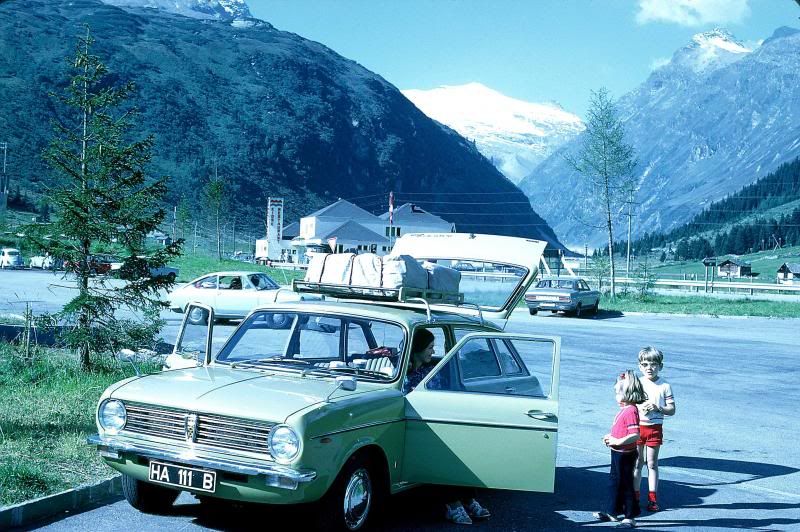
This Volvo served us very well too. I also bought a trailer tent and toured (camped) the continent extensively; Germany of course, Holland, France, Austria, Switzerland and Italy. Camping in Italy provided the best family holidays ever.

Going down into Italy over the San Bernadino pass with a four-mile-long tunnel at the highest point. Cloudy, damp and cold as one entered the tunnel on the north side, only to emerge on the south side into warm and sunny weather - brilliant!
As the views below show, Switzerland provided the most spectacular scenery anywhere I’ve been in the world.

The Volvo parked by the lake was on Lake Lucerne, (in German: Vierwaldstättersee, “Lake of the Four Forested Cantons”) in Switzerland not far from TellsKappelle. The TellsKapelle (“Tell’s chapel”) is located on the shore of Lake Lucerne and marks the site where according to legend, William Tell (he of the shooting an apple off his son’s head fame) initiated the rebellion that led to the foundation of the Old Swiss Confederacy back in the 14th century. Also a little further along the lakeside is the town of Fluelen where my wife, following graduation from cookery school, worked as an under-chef at a hotel. So we had to visit that too.

The William Tell Express paddle steamer plied its way along the towns on the edge of Lake Lucerne
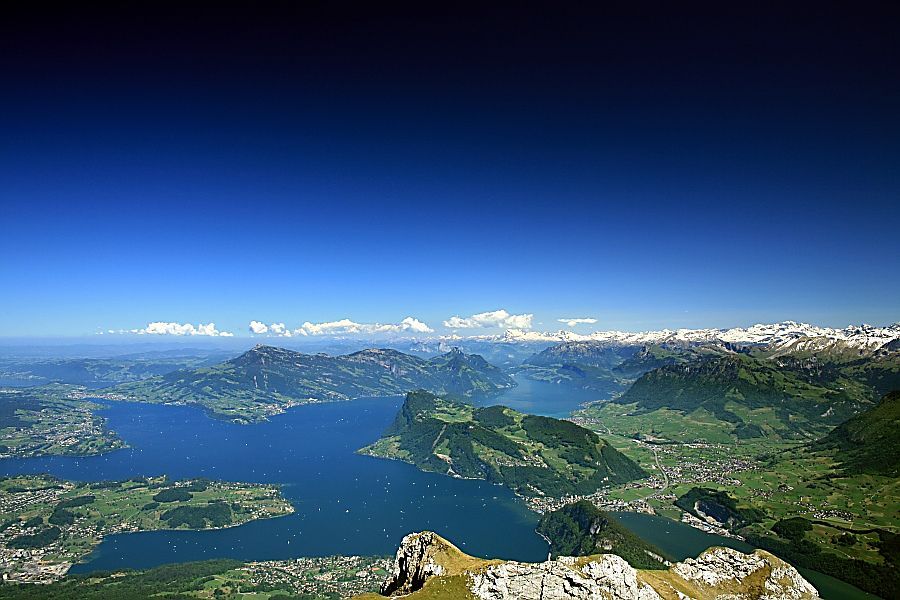
View of the lake from Mount Pilatus (2,128 m) a mountain overlooking Lake Lucerne. The summit is reached by a cog-wheel railway.

The Rigi is another mountain summit that is reached by cog railway, again with spectacular views.
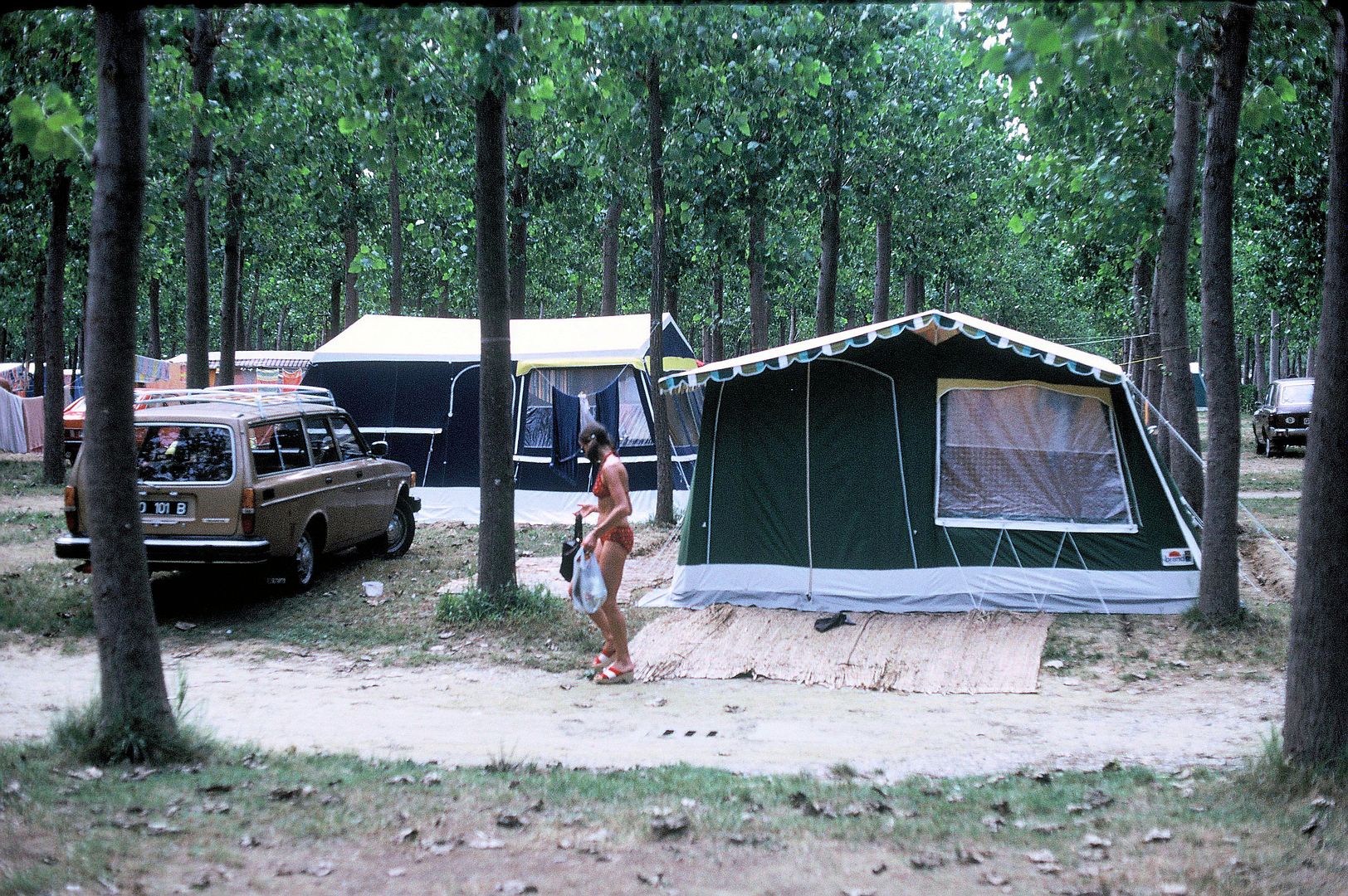
Camping in Italy near Venice

Week-end camping visit alongside the river Mosel in Germany. Trailer-tent in use c/w built-in sink and two-ring gas stove. The tent could unfolded and erected in minutes - wonderful!
Anyway back to the 1970’s.
The Austin Maxi did well in Germany and beyond. Here it is as we went south to Italy in our first year in Germany (1971).

This Volvo served us very well too. I also bought a trailer tent and toured (camped) the continent extensively; Germany of course, Holland, France, Austria, Switzerland and Italy. Camping in Italy provided the best family holidays ever.

Going down into Italy over the San Bernadino pass with a four-mile-long tunnel at the highest point. Cloudy, damp and cold as one entered the tunnel on the north side, only to emerge on the south side into warm and sunny weather - brilliant!
As the views below show, Switzerland provided the most spectacular scenery anywhere I’ve been in the world.

The Volvo parked by the lake was on Lake Lucerne, (in German: Vierwaldstättersee, “Lake of the Four Forested Cantons”) in Switzerland not far from TellsKappelle. The TellsKapelle (“Tell’s chapel”) is located on the shore of Lake Lucerne and marks the site where according to legend, William Tell (he of the shooting an apple off his son’s head fame) initiated the rebellion that led to the foundation of the Old Swiss Confederacy back in the 14th century. Also a little further along the lakeside is the town of Fluelen where my wife, following graduation from cookery school, worked as an under-chef at a hotel. So we had to visit that too.

The William Tell Express paddle steamer plied its way along the towns on the edge of Lake Lucerne

View of the lake from Mount Pilatus (2,128 m) a mountain overlooking Lake Lucerne. The summit is reached by a cog-wheel railway.

The Rigi is another mountain summit that is reached by cog railway, again with spectacular views.

Camping in Italy near Venice

Week-end camping visit alongside the river Mosel in Germany. Trailer-tent in use c/w built-in sink and two-ring gas stove. The tent could unfolded and erected in minutes - wonderful!
Last edited by Warmtoast; 21st Mar 2014 at 22:34.
1959-1963 I remember the many occasions when we flew back to the UK in a freight or Pax/freight role and offered the empty freight space to Air Movements at Changi or Khormaksar. They in turn would regularly put a couple of servicemen’s private cars aboard as “indulgence” freight
Nice Ford Zodiac....Splash. Shame about the MGA....Splash. Big Mercedes Splash.
No comeback, no insurance.
We still use the Puttgarden -Røby ferry when we drive to our son's in Copenhagen - there are rumours that replacement with a bridge is being considered. However, there is an interesting story about the Oresund bridge between Copenhagen and Malmo. Prostitution, or at least "employing" a prostitute is illegal in Sweden, so at night the Oresund bridge is busy with Swedes travelling to Denmark for that purpose.
The Roskilde museum is brilliant, and the replica long-ship built there was subject of a TV programme last year as it was sailed back to Dublin, where its predecessor had been built 1000years before
The Roskilde museum is brilliant, and the replica long-ship built there was subject of a TV programme last year as it was sailed back to Dublin, where its predecessor had been built 1000years before
Last edited by Wander00; 22nd Mar 2014 at 11:40. Reason: added a bit
Guest
Posts: n/a
All our yesterdays.
Warmtoast,
What a wonderful group of holiday snaps ! And a lovely pic of the Mosel vineyard slopes. The Mosel valley was quite handy for Geilenkirchen, and their wine was one of our favourites. Little shop in town sold it at Dm2 a bottle (10 pfennig back on the bottle). In winter we used to leave it on outside kitchen windowsill to cool. Delicious !
I think the Import regulations must have relaxed between our dates. I believe the two year-rule was in force throughout our tour ('60/'62). This meant that if we wanted to change cars (as you did), we had to do it in our first year. The 404 had been announced a fortnight after I got my 403 (and I could have got a Coupleur Jaeger on the 404, too). But the German agent now wanted £100 plus my 403, and I reckoned that too much...D.
What a wonderful group of holiday snaps ! And a lovely pic of the Mosel vineyard slopes. The Mosel valley was quite handy for Geilenkirchen, and their wine was one of our favourites. Little shop in town sold it at Dm2 a bottle (10 pfennig back on the bottle). In winter we used to leave it on outside kitchen windowsill to cool. Delicious !
I think the Import regulations must have relaxed between our dates. I believe the two year-rule was in force throughout our tour ('60/'62). This meant that if we wanted to change cars (as you did), we had to do it in our first year. The 404 had been announced a fortnight after I got my 403 (and I could have got a Coupleur Jaeger on the 404, too). But the German agent now wanted £100 plus my 403, and I reckoned that too much...D.
Guest
Posts: n/a
Re: Post #4733, Page 237.
MPN11,
I have been meaning for some time to return at greater length to the subject of the cavalier way in which you were "withdrawn" ("flung off" might have been a better expression) from flying training in the Navy. You gave the full, sad details last December, (in your #4733 p.237), but briefly I recall that, after some 30 hrs (and a PPL) on nosewheels, you had trouble with the Tiger (who didn't ?)
Let's look at what we all know. This "Twin-Winged-Lord-of-the-Air" idea is nonsense. Any fool can fly an aeroplane in the air (and many fools do). Aeroplane flies itself quite well without much (or any) help from you. You merely have to learn two tricks - a little one and a big one. Little one is to get it off the ground into the air (which amounts to giving it "welly" and keeping it straight). Big one is to put it back again (in one piece if possible).
There are only two ways to do this. The old (tail-dragger) way, in which you (hopefully) have arranged affairs so that it gives up the unequal struggle with gravity not more than a couple of feet above ground and flops down more or less where you want it (this was called "Landing"). It was also called a "three-pointer", or "daisy-cutter"; it looked very nice when you managed to do it properly and you felt well pleased with yourself.
Or the new (nosewheel) way, in which you fly it onto (into ?) the Runway (or whatever), secure in the knowledge that any remaining lift will disappear as the nosewheel goes down (this is called "Landing",too, but it ain't). Even in the old way there were times when you couldn't quite pull it off, and had to push it hard down on the wheels to keep it there till it slowed down (this was called "Doing a Wheeler", and generally deprecated as sloppy flying).
When it came to the Great Changeover in the '50s, the transit (for me) after 600 hrs taildragging to the New Way (Meteor 7) was easy. "Just do wheelers !" said my QFI. So I did.
But transit back from New to Old was much harder. Geriaviator records (and my own experience bears out, after only 16 hrs "New") that all FJs had trouble with the Tiger at first. Why would you not, after your first 30 hours all on nosewheels ? Paradoxically, you might've stood a better chance if you'd never flown at all before ! They should have given you much more time - was there a War on ? I reckon you were unfairly treated.
Look at it from the Navy's point of view. Here you have a keen and willing youngster. He's got himself a gliding B Licence (and you don't "three-point" a glider), he'd joined the ATC Cadets and put his back into it to the extent of being awarded a Flying Scholarship. Thirty hours nearly all nosewheel later he's got a PPL. Isn't he exactly the kind of Right Stuff the Navy should be looking for ? What next ?
At this stage the Navy's got rid of its last carrier tail-dragging piston (Sea Fury retired '55 [Wiki], now it's '62). Every operational aircraft he'll fly in years to come will be a nosewheel. So what do their Lordships give him to fly now ? This old pterodactyl, for pity's sake ! Essentially a domesticated version of "Biggles's" 1917 Camel, the Tiger Moth had trained thousands of lads (who'd mostly never been in the air in their lives before) to fly in the Old Way. These would later fly the Spitfires and Hurricanes which saved Britain in '40, and the Lancasters and Halifaxes which were Harris's bludgeons of the Third Reich in '42-'44.
All these were tail-draggers. Now the Tiger had done its work; nearly all stations had their "pet" Tiger in a hangar, to be brought out to provide great fun on sunny afternoons.
The Jet Provost had come into service in the RAF in '58 (Wiki). Four years before. Couldn't the Navy get hold of even a dozen (everyone else in the world seems to have been able to get some) ? Seemingly not. They put their chap in a Tiger: he struggled: they scrubbed him. Doesn't make much sense, does it ?
Funny Post (hopefully) next time....Danny.
I have been meaning for some time to return at greater length to the subject of the cavalier way in which you were "withdrawn" ("flung off" might have been a better expression) from flying training in the Navy. You gave the full, sad details last December, (in your #4733 p.237), but briefly I recall that, after some 30 hrs (and a PPL) on nosewheels, you had trouble with the Tiger (who didn't ?)
Let's look at what we all know. This "Twin-Winged-Lord-of-the-Air" idea is nonsense. Any fool can fly an aeroplane in the air (and many fools do). Aeroplane flies itself quite well without much (or any) help from you. You merely have to learn two tricks - a little one and a big one. Little one is to get it off the ground into the air (which amounts to giving it "welly" and keeping it straight). Big one is to put it back again (in one piece if possible).
There are only two ways to do this. The old (tail-dragger) way, in which you (hopefully) have arranged affairs so that it gives up the unequal struggle with gravity not more than a couple of feet above ground and flops down more or less where you want it (this was called "Landing"). It was also called a "three-pointer", or "daisy-cutter"; it looked very nice when you managed to do it properly and you felt well pleased with yourself.
Or the new (nosewheel) way, in which you fly it onto (into ?) the Runway (or whatever), secure in the knowledge that any remaining lift will disappear as the nosewheel goes down (this is called "Landing",too, but it ain't). Even in the old way there were times when you couldn't quite pull it off, and had to push it hard down on the wheels to keep it there till it slowed down (this was called "Doing a Wheeler", and generally deprecated as sloppy flying).
When it came to the Great Changeover in the '50s, the transit (for me) after 600 hrs taildragging to the New Way (Meteor 7) was easy. "Just do wheelers !" said my QFI. So I did.
But transit back from New to Old was much harder. Geriaviator records (and my own experience bears out, after only 16 hrs "New") that all FJs had trouble with the Tiger at first. Why would you not, after your first 30 hours all on nosewheels ? Paradoxically, you might've stood a better chance if you'd never flown at all before ! They should have given you much more time - was there a War on ? I reckon you were unfairly treated.
Look at it from the Navy's point of view. Here you have a keen and willing youngster. He's got himself a gliding B Licence (and you don't "three-point" a glider), he'd joined the ATC Cadets and put his back into it to the extent of being awarded a Flying Scholarship. Thirty hours nearly all nosewheel later he's got a PPL. Isn't he exactly the kind of Right Stuff the Navy should be looking for ? What next ?
At this stage the Navy's got rid of its last carrier tail-dragging piston (Sea Fury retired '55 [Wiki], now it's '62). Every operational aircraft he'll fly in years to come will be a nosewheel. So what do their Lordships give him to fly now ? This old pterodactyl, for pity's sake ! Essentially a domesticated version of "Biggles's" 1917 Camel, the Tiger Moth had trained thousands of lads (who'd mostly never been in the air in their lives before) to fly in the Old Way. These would later fly the Spitfires and Hurricanes which saved Britain in '40, and the Lancasters and Halifaxes which were Harris's bludgeons of the Third Reich in '42-'44.
All these were tail-draggers. Now the Tiger had done its work; nearly all stations had their "pet" Tiger in a hangar, to be brought out to provide great fun on sunny afternoons.
The Jet Provost had come into service in the RAF in '58 (Wiki). Four years before. Couldn't the Navy get hold of even a dozen (everyone else in the world seems to have been able to get some) ? Seemingly not. They put their chap in a Tiger: he struggled: they scrubbed him. Doesn't make much sense, does it ?
Funny Post (hopefully) next time....Danny.
Danny. You may have read that even experienced FJ pilots joining the BBMF have to have about 5 hours on Chipmunks and the same on Harvards before flying the Hurricane and then later the Spitfire.
mmitch.
mmitch.
Join Date: Mar 2010
Location: Often in Jersey, but mainly in the past.
Age: 79
Posts: 7,803
Received 135 Likes
on
63 Posts
Danny42C ... how kind, Sir 
I do take the point that it might have been better if I hadn't logged those 30 hours with a nose wheel. Indeed, the Piper Colt was so easy to fly (5:35 to first solo) and vice-free (we had to do 30 minutes in a Chipmunk [G-AOFF in my case] doing proper stalls and spins and a touch of aeros) that it was hardly a challenging introduction to the wonders of flight!
However, I'm sure the RN had their reasons. We were allocated 12 hours on the Tiger Moth to demonstrate we had the ability to be taught, and if it had been as easy as the Colt it wouldn't have proved a lot! I might have done better with a non-screaming Instructor, as noted in that previous post, but I have learned to live with the bottom line ... I wasn't really that good, and the RN had more promising material to work with
Looking forward to your next instalment, O Burner of the Midnight Oil.

I do take the point that it might have been better if I hadn't logged those 30 hours with a nose wheel. Indeed, the Piper Colt was so easy to fly (5:35 to first solo) and vice-free (we had to do 30 minutes in a Chipmunk [G-AOFF in my case] doing proper stalls and spins and a touch of aeros) that it was hardly a challenging introduction to the wonders of flight!
However, I'm sure the RN had their reasons. We were allocated 12 hours on the Tiger Moth to demonstrate we had the ability to be taught, and if it had been as easy as the Colt it wouldn't have proved a lot! I might have done better with a non-screaming Instructor, as noted in that previous post, but I have learned to live with the bottom line ... I wasn't really that good, and the RN had more promising material to work with

Looking forward to your next instalment, O Burner of the Midnight Oil.
Join Date: Jan 2014
Location: Stoke-on-Trent
Age: 91
Posts: 366
Likes: 0
Received 0 Likes
on
0 Posts
Chugalug, Danny and smujsmith,
Re my #5279, thank you for your valued comments. I have been searching my memory (I'm surprised I remembered that much!) to check where 'my' aircraft flew from. The Dakota was fitted out for the para role (seats down the side) and parked on the field were a number of wartime gliders - Horsa, IIRC. I have a photo of me proudly standing in front of one Dak. But where was it? Lost in the mists of time. The Lincoln, airfield unknown, but a clue may be that one of them had the code LS-D and a photo of this one should be among my possessions, as is a picture of the assembled 304 Squadron cadets in front of one. The Dominie - first RAF aircraft I flew in - and Washington trips have self-erased from my data bank, although I remember going down the tubular tunnel into the B29 rear gunner's position.
Sat at the WOP's position in a Wellington but unfortunately it was stationary on the ground. RAF Swinderby.
Soon, first instalment of my RAF career.
___
HM ('More to follow', IIRC. Ignore if incorrect as it'll make no sense)
Re my #5279, thank you for your valued comments. I have been searching my memory (I'm surprised I remembered that much!) to check where 'my' aircraft flew from. The Dakota was fitted out for the para role (seats down the side) and parked on the field were a number of wartime gliders - Horsa, IIRC. I have a photo of me proudly standing in front of one Dak. But where was it? Lost in the mists of time. The Lincoln, airfield unknown, but a clue may be that one of them had the code LS-D and a photo of this one should be among my possessions, as is a picture of the assembled 304 Squadron cadets in front of one. The Dominie - first RAF aircraft I flew in - and Washington trips have self-erased from my data bank, although I remember going down the tubular tunnel into the B29 rear gunner's position.
Sat at the WOP's position in a Wellington but unfortunately it was stationary on the ground. RAF Swinderby.
Soon, first instalment of my RAF career.
___
HM ('More to follow', IIRC. Ignore if incorrect as it'll make no sense)



